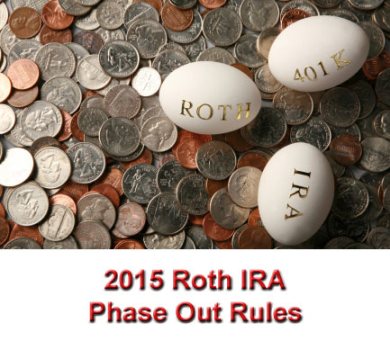 |
 |
|
|
2015 Roth IRA Phase Out Rules
What are the 2015 Roth IRA phase out rules? Is it true that your Roth IRA contribution limit phases out as your income rises? Yes, it's true. So if you plan to make a Roth IRA contribution this year, you need to know the 2015 phase out rules. Otherwise, you risk inadvertently contributing more than the allowable IRS limit. Let's take a look at when the contribution limits phase out, how much they phase out, and how it all effects you. The 2015 Roth IRA Phase Out RangeIf you earn less than a certain amount of money each year, you qualify to make the maximum allowable contribution to your Roth IRA. Likewise, if you earn too much, you're barred from making any contribution at all. But what happens when your income falls somewhere in between those two extremes?  In such cases, your maximum contribution limit phases out according to where your income falls on a sliding scale. So what are these income ranges according to the 2015 Roth IRA phase out rules? For 2015, your Roth IRA maximum contribution limit phases out if...
Exactly where your income falls within the ranges outlined above determines how much you can contribute. So what happens if your income falls within one of these ranges? What's your maximum contribution limit? Your maximum contribution limit varies dramatically depending on your exact income. So figuring out your contribution limit requires a bit of calculation. Calculating 2015 Roth IRA Phase Out Contributions
So how do you calculate a 2015 Roth IRA phase out contribution? The short answer... On a percentage basis. One way to calculate your 2015 contribution limit is to take your income, subtract the maximum income you can earn while still making the maximum contribution, and divide that figure by the phase out range for your tax filing status. Easy! Right? Don't worry, it's really NOT that complicated. Sometimes the best way to illustrate a point is by showing instead of telling. So let's learn the 2015 Roth IRA phase out rules by looking at an example for each tax filing status... Married Filing JointlyLet's say you're married and filing a joint tax return with your spouse. For such persons, the 2015 Roth IRA phase out rules take effect if you earn between $183,001 and $193,000. You and your spouse are both 46 years old with a combined income of $188,000. At first glance, it's clear that you're ineligible to make the maximum $5,500 contribution, but it's also clear that you haven't surpassed the $193,000 threshold which bars you from making a contribution. So how much can you contribute? First, subtract the maximum contribution income limit ($183,000) from your income... $188,000 - $183,000 = $5,000 That gives you $5,000. Now, divide that $5,000 by the phase out range of $10,000 ($193,000 - $183,000) designated for your tax filing status... $5,000 / $10,000 = 50% That gives you 50%. So what does that mean? According to the 2015 Roth IRA phase out rules, you can make a contribution that's 50% less than the maximum Roth IRA contribution for your age bracket. In this case, your contribution limit is 50% of $5,500, or... $2,750. So, in this case, $2,750 is the maximum amount you can contribute. Once you reach age 50 and the maximum Roth IRA contribution rises to $6,500, your contribution limit under the same circumstances is 50% of $6,500. Which, of course, is $3,250. Does that make sense? Let's try another example... Single, Head of Household, or Married Filing Separately (And Didn't Live With Your Spouse)Let's say you file your taxes as head of household. In such a case, the 2015 Roth IRA phase out rules take effect if you earn between $116,001 and $131,000. Let's also say you're 28 years old with an earned income of $120,500. Since your income falls within the $116,001 to $131,000 range, how much can you contribute? First, subtract the maximum contribution income limit ($116,000) from your income... $120,500 - $116,000 = $4,500 That gives you $4,500. Now, divide that $4,500 by the phase out range of $15,000 ($131,000 - $116,000) designated for your tax filing status... $4,500 / $15,000 = 30% That gives you 30%. So what does that mean? According to the 2015 Roth IRA phase out rules, it means you can make a contribution that's 30% less than the maximum Roth IRA contribution for your age bracket. In this case, your contribution limit is 70% of $5,500, or... $3,850. So, in this case, $3,850 is the maximum amount you can contribute. If you're 50 years old or older instead of 28, the maximum Roth IRA contribution limit is $6,500. So your contribution limit under the same circumstances above is 70% of $6,500... or $4,550. Is this starting to make sense? Let's try one more example... Married Filing Separately (And Lived With Your Spouse)Let's say you're married, but you file your taxes separately from your spouse. But you aren't separated from your spouse. You both remain happily married. How do the 2015 Roth IRA phase out rules effect you? For such people, the 2015 Roth IRA phase out rules take effect if you earn between $1 and $10,000. Let's say you're 35 years old and you work part-time making $7,800 per year. Your spouse works full-time and the two of you live off of your spouse's income. That means your income is free to fund your Roth IRA. But since your income falls within the $1 to $10,000 range, you aren't sure of your contribution limit. Exactly how much can you contribute? First, subtract the maximum contribution income limit ($0) from your income... $7,800 - $0 = $7,800 That gives you $7,800. Now, divide that $7,800 by the phase out range of $10,000 ($10,000 - $0) designated for your tax filing status... $7,800 / $10,000 = 78% That gives you 78%. So what does that mean? It means you can make a contribution that's 78% less than the maximum Roth IRA contribution for your age bracket. In this case, your contribution limit comes to 22% of $5,500, or... $1,210. So $1,210 is the maximum amount you can contribute. But what if you're 55 instead of 35? What's your limit then? Simply calculate 22% of $6,500... Which comes out to $1,430. Does that make sense? Good. It's really simple once you get the hang of it. Just make sure to keep the following rules in mind. Two 2015 Roth IRA Phase Out Rules to RememberWhile the basic math used in the examples above still applies, you aren't always going to have earned income that's a nice round number, are you? So when performing your 2015 Roth IRA phase out calculations, keep these rules in mind... 1) Even $10 Intervals - If you calculate your maximum phase out contribution, and it doesn't provide you with an even $10 interval, simply round up to the next highest $10 interval. 2) A $200 Minimum - You can't have a maximum Roth IRA contribution limit of less than $200 unless you're ineligible to contribute at all. So if your 2015 Roth IRA phase out contribution calculation tells you you're eligible to contribute $150, round that figure up to $200. The 2015 Roth IRA Phase Out Rules and Catch Up ContributionsSo how does all of this effect 2015 Roth IRA catch up contributions? Hopefully, the above examples helped to explain that. But just to reiterate... If you qualify to make the maximum Roth IRA contribution possible, you can contribute...
Both of these contribution limits phase out according to where your income falls within the limit range. But as a general rule, catch up contributions are always the maximum contribution limit for someone younger than 50 with the same income and tax filing status, plus 20%... So if you're over the age of 50, just calculate what your contribution limit would be if you were under the age of 50. Then, tack on an extra 20%. It's really that simple... But don't forget your $10 interval or $200 minimum contribution limit rules! ConclusionThe maximum contribution limit on your Roth IRA phases out as you earn more than the IRS income limit designated for your tax filing status. So before you go ahead and make the maximum annual Roth IRA contribution, make sure your income doesn't place you within the range where your contribution limits phase out. Use a percentage basis to calculate your Roth IRA phase out contribution limit. But remember, round off your contribution limit to the next highest $10 interval if it's not already an interval of $10. And if you're eligible to make a contribution, but your calculations tell you your maximum limit is less than $200, round that number up to $200. Follow these 2015 Roth IRA phase out rules, and you'll have no problem at all calculating your precise Roth IRA contribution limit for the upcoming year.
Check out our new Facebook Page and follow us on Twitter!
Return to the top of 2015 Roth IRA Phase Out Rules Return to 2015 Roth IRA Limits Return to the Your Roth IRA Website Homepage
|
What's New?Read 5 Reasons Why I Love My Roth IRA, our part in the Good Financial Cents Roth IRA Movement! Start planning ahead for next year by checking out 2017 Roth IRA contribution limits, and stay alert to this year's changes to the 2016 Roth IRA contribution limits. Our family fully funds our Roth IRA with this website. Learn how you can do it too. Are you confused or frustrated by the stock market? Learn how to build real wealth selecting individual stocks for your Roth IRA... Read more about what's new on the Roth IRA blog. Hi, I'm Britt, and this is my wife, Jen. Welcome to our Roth IRA information website! This is our humble attempt to turn a passion for personal finance into the Web's #1 resource for Roth IRA information. But, believe it or not, this site is more than just a hobby. It's a real business that provides a stable and steady stream of income for our family. In fact, because of this site, Jen is able to be a full-time stay-at-home mom and spend more time with our daughter, Samantha. But you want to know the best part? ...You can do the same thing! Anyone with a hobby or a passion (even with no previous experience building a website) can create a profitable site that generates extra income. If you're tired of solely depending on your job(s) for family income, click here now and learn why our income is increasing despite the financial crisis and how we're making our dreams come true. |
|
Search This SiteRoth IRA BasicsMore About Roth IRAsRoth IRA ResourcesAbout Your Roth IRALike Us On FacebookFollow Us On Twitter
RSSDisclaimerThe information contained in Your Roth IRA is for general information purposes only and does not constitute professional financial advice. Please contact an independent financial professional when seeking advice regarding your specific financial situation. For more information, please consult our full Disclaimer Policy as well as our Privacy Policy. Thank YouOur family started this site as a labor of love in February 2009, a few months after our daughter was born. Thank you for helping it become one of the most visited Roth IRA information sites. Thank you, too, to the "SBI!" software that made it all possible. We hope you find what you're looking for and wish you much continued success in your retirement planning! |
||
|
| ||






